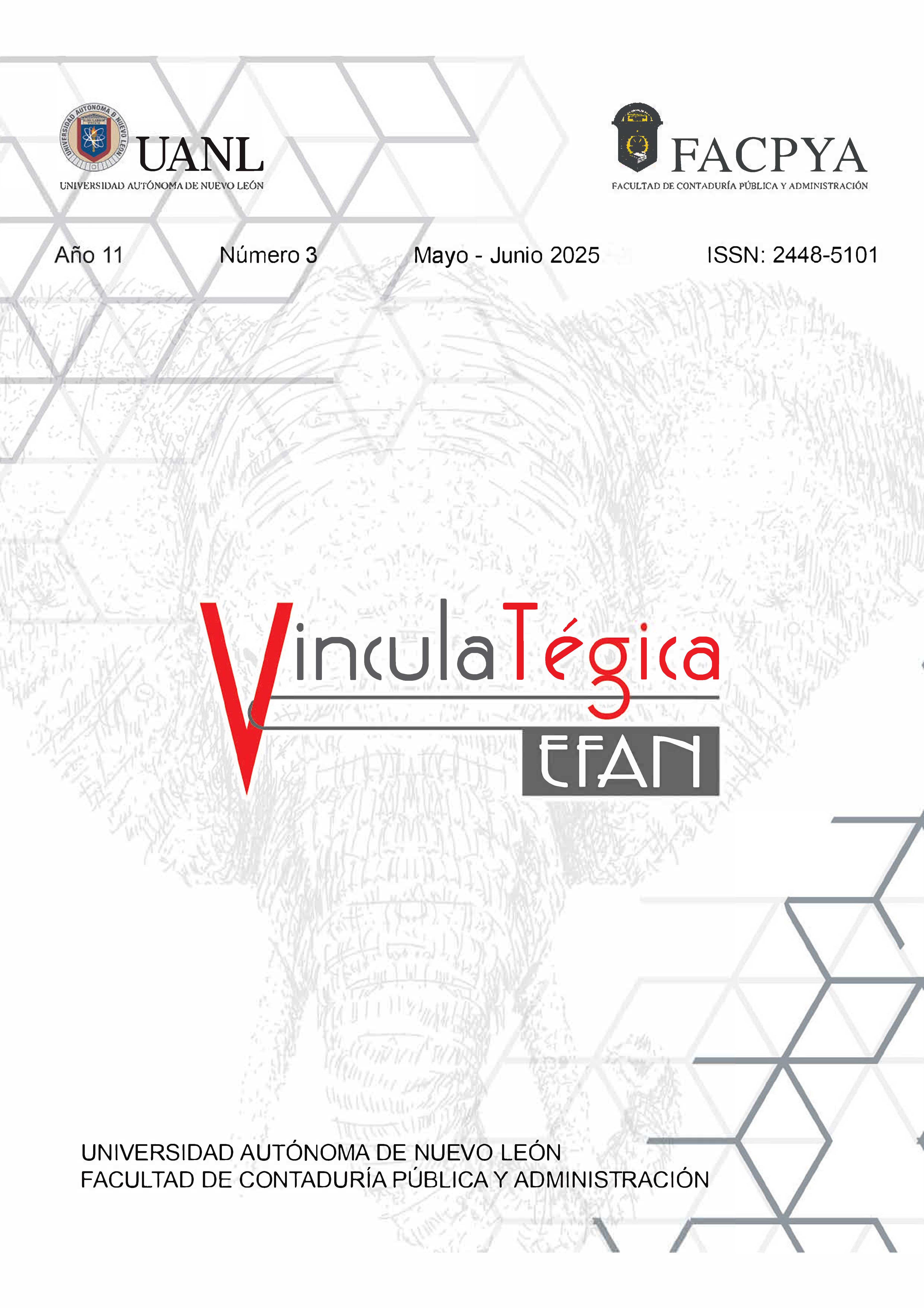Elaboración de un instrumento de medición para la Aceptación de una plataforma de inteligencia artificial
DOI:
https://doi.org/10.29105/vtga11.3-1141Palabras clave:
Inteligencia Artificial, ChatGPT, Desarrollo académico, Instrumento de medición, Aceptación de la IAResumen
Actualmente la Inteligencia Artificial (IA) se ha consolidado en el ámbito científico, tecnológico y educativo. Herramientas como el ChatGPT ayudan en la búsqueda de información y en la realización de diversas actividades, teniendo una interacción entre humanos y maquinas. La aceptación de esta plataforma de IA en ámbito educativo, al ser una herramienta prometedora, incita a los estudiantes a adoptarla en su día a día, por lo cual genera un impacto en su desarrollo académico. Por lo anterior, el presente estudio tiene como objetivo elaborar un instrumento de medición para la aceptación de una plataforma de inteligencia artificial. Es importante mencionar que se realizó una búsqueda exhaustiva y sistemática de la literatura para identificar tanto los factores que inciden en la aceptación de la tecnología como aquellos ítems para su medición. Así mismo, el tipo de investigación en este estudio es exploratorio y descriptivo, ya que, a través de la revisión de literatura en bases de datos especializadas, se logró identificar y definir el fenómeno de estudio. Gracias a los resultados obtenidos se logro elaborar un instrumento de medición, así como un modelo causal con el cual se podrá medir el nivel de aceptación de la aplicación de la IA.
Descargas
Citas
Abdaljaleel, M., Barakat, M., Alsanafi, M., Salim, N. A., Abazid, H., Malaeb, D. & Sallam, M. (2024). A multinational study on the factors influencing university students’ attitudes and usage of ChatGPT. Scientific Reports, 14(1), 1983. DOI: https://doi.org/10.1038/s41598-024-52549-8
Ajzen, I. (2020). The theory of planned behavior: Frequently asked questions. Human behavior and emerging technologies, 2(4), 314-324. DOI: https://doi.org/10.1002/hbe2.195
Ajzen, I., Fishbein, M. (1980). Understanding attitudes and predicting social behavior. Englewood Cliffs, Nueva Jersey, Prentice-Hall.
Bedregal-Alpaca, N., Cornejo-Aparicio, V., Tupacyupanqui-Jaén, D., & Flores-Silva, S. (2019). Evaluación de la percepción estudiantil en relación al uso de la plataforma Moodle desde la perspectiva del TAM. Ingeniare. Revista chilena de ingeniería, 27(4), 707-718. DOI: https://doi.org/10.4067/S0718-33052019000400707
Chaudhry, M. A., & Kazim, E. (2022). Artificial Intelligence in Education (AIEd): A high-level academic and industry note 2021. AI and Ethics, 2(1), 157-165. DOI: https://doi.org/10.1007/s43681-021-00074-z
Cheema, U., Rizwan, M., Jalal, R., Durrani, F., & Sohail, N. (2013). The trend of online shopping in 21st century: Impact of enjoyment in TAM Model. Asian journal of empirical research, 3(2), 131-141.
Davis, F. D. (1989). Perceived usefulness, perceived ease of use, and user acceptance of information technology. MIS Quarterly 13(3):319-340. DOI: https://doi.org/10.2307/249008
Davis, F. D., Bagozzi, R. P., Warshaw, P. R. (1989). User acceptance of computer technology: A comparison of two theoretical models. Management Science 35(8):982-1003. DOI: https://doi.org/10.1287/mnsc.35.8.982
García-Peñalvo, F. J. (2023). La percepción de la Inteligencia Artificial en contextos educativos tras el lanzamiento de ChatGPT: disrupción o pánico. Education in the Knowledge Society (EKS), 24, e31279-e31279. DOI: https://doi.org/10.14201/eks.31279
Giansanti, D. (2023). Precision Medicine 2.0: How digital health and AI are changing the game. Journal of Personalized Medicine, 13(7), 1057. DOI: https://doi.org/10.3390/jpm13071057
Haleem, A., Javaid, M. y Singh, R. P. (2022). An era of ChatGPT as a significant futuris¬tic support tool: a study on features, abilities, and challenges. BenchCouncil Transactions on Benchmarks, Standards and Evaluations, 2(4), 1-8. DOI: https://doi.org/10.1016/j.tbench.2023.100089
Hasanein, A. M., & Sobaih, A. E. E. (2023). Drivers and Consequences of ChatGPT Use in Higher Education: Key Stakeholder Perspectives. European Journal of Investigation in Health, Psychology and Education, 13(11), 2599-2614. DOI: https://doi.org/10.3390/ejihpe13110181
Hulleman, C. S., & Harackiewicz, J. M. (2009). Promoting interest and performance in high school science classes. science, 326(5958), 1410-1412. DOI: https://doi.org/10.1126/science.1177067
Ibrahim, H., Liu, F., Asim, R., Battu, B., Benabderrahmane, S., Alhafni, B. & Zaki, Y. (2023). Perception, performance, and detectability of conversational artificial intelligence across 32 university courses. Scientific Reports, 13(1), 12187. DOI: https://doi.org/10.1038/s41598-023-43998-8
Kamalov, F., Santandreu Calonge, D., & Gurrib, I. (2023). New era of artificial intelligence in education: Towards a sustainable multifaceted revolution. Sustainability, 15(16), 12451. DOI: https://doi.org/10.3390/su151612451
Khechine, H., Raymond, B. y Augier, M. (2020). La adopción de un sistema de aprendizaje social: valor intrínseco en el modelo UTAUT. Revista británica de tecnología educativa, 51 (6), 2306–2325. DOI: https://doi.org/10.1111/bjet.12905 DOI: https://doi.org/10.1111/bjet.12905
Kim, S. G. (2023). Using ChatGPT for language editing in scientific articles. Maxillofacial plastic and reconstructive surgery, 45(1), 13. DOI: https://doi.org/10.1186/s40902-023-00381-x
Korteling, J. H., van de Boer-Visschedijk, G. C., Blankendaal, R. A., Boonekamp, R. C., & Eikelboom, A. R. (2021). Human-versus artificial intelligence. Frontiers in artificial intelligence, 4, 622364. DOI: https://doi.org/10.3389/frai.2021.622364
Lanlan, Z., Ahmi, A., & Popoola, O. M. J. (2019). Perceived ease of use, perceived usefulness and the usage of computerized accounting systems: A performance of micro and small enterprises (mses) in china. International Journal of Recent Technology and Engineering, 8(2), 324-331. DOI: https://doi.org/10.35940/ijrte.B1056.0782S219
Montenegro-Rueda, M., Fernández-Cerero, J., Fernández-Batanero, J. M., & López-Meneses, E. (2023). Impact of the implementation of ChatGPT in education: A systematic review. Computers, 12(8), 153. DOI: https://doi.org/10.3390/computers12080153
Nazir, A., & Wang, Z. (2023). A comprehensive survey of ChatGPT: advancements, applications, prospects, and challenges. Meta-radiology, 1(2), 100022. DOI: https://doi.org/10.1016/j.metrad.2023.100022
oJultNCHuAM&t=22s34nbq60
Ongena, G., van de Wijngaert, L., & Huizer, E. (2013). Acceptance of online audio-visual cultural heritage archive services: a study of the general public.
Ramírez-Correa, P. (2014). Uso de internet móvil en Chile: explorando los antecedentes de su aceptación a nivel individual. Ingeniare. Revista chilena de ingeniería, 22(4), 560-566. DOI: https://doi.org/10.4067/S0718-33052014000400011
Ray, P. P. (2023). ChatGPT: a comprehensive review on background, applications, key challenges, bias, ethics, limitations and future scope. Internet of Things and Cyber-Physical Systems, 3, 121-154. DOI: https://doi.org/10.1016/j.iotcps.2023.04.003
Rubaceti, B., & Alida, N. (2021). La influencia social en el proceso de inclusión y bancarización fintech de usuarios emprendedores en Colombia a través del modelo de aceptación de tecnología Tam (Doctoral dissertation, Universidad Francisco de Paula Santander).
Sampieri, H., & Collado, R. F. (2010). C. y Baptista Lucio, P.(2010). Metodología de la investigación, 6.
Solano, A. V. C., Arboleda, L. D. C., García, C. C. C., & Dominguez, C. D. C. (2023). Benefits of artificial intelligence in companies. AG Managment, 1, 17-17. DOI: https://doi.org/10.62486/agma202317
Suárez-Escalona, R., Estrada-Domínguez, J. E., Infante-Alcántara, L. & Cavazos-Salazar, R. L. (2023). Análisis de la aceptación de una plataforma de enseñanza aprendizaje en la universidad. Formación universitaria, 16(1), 23-32. DOI: https://doi.org/10.4067/S0718-50062023000100023
Tong, Y. y Zhang, L. (2023). Descubriendo las tendencias de investigación en biología sintética de la próxima década. Biotecnología sintética y de sistemas, 8(2), 220–223.
UNESCO. (2019). Informe de los Objetivos de Desarrollo Sostenible. Recuperado de https://bit.ly/
Venkatesh, V., & Davis, F. D. (2000). A theoretical extension of the technology acceptance model: Four longitudinal field studies. Management science, 46(2), 186-204. DOI: https://doi.org/10.1287/mnsc.46.2.186.11926
Venkatesh, V., Morris, M., Davis, G., y Davis, F. (2003). User Acceptance of Information Technology: Towards a Unified View. MIS Quarterly, 27(3), 479–501. DOI: https://doi.org/10.2307/30036540
Wicaksono, A. R., Maulina, E., Rizal, M., & Purnomo, M. (2023). Technology Accepted Model (TAM): Applications in Accounting Systems. Journal of Law and Sustainable Development, 11(5), e547-e547. DOI: https://doi.org/10.55908/sdgs.v11i5.547
Zhang, P., & Tur, G. (2024). A systematic review of ChatGPT use in K‐12 education. European Journal of Education, 59(2), e12599. DOI: https://doi.org/10.1111/ejed.12599
Descargas
Publicado
Cómo citar
Número
Sección
Licencia
Derechos de autor 2024 Diana Karina Rodriguez Amaya, Jesus Eduardo Estrada Domínguez

Esta obra está bajo una licencia internacional Creative Commons Atribución 4.0.
Los autores que publiquen en la revista VinculaTégica EFAN aceptan el siguiente aviso de derechos de autor:
a). Los autores conservan los derechos de autor y ceden a la revista el derecho de la primera publicación de la obra bajo una licencia de atribución de Creative Commons. Esta licencia permite a otros compartir la obra siempre que se reconozca la autoría original y la publicación inicial en esta revista.
b). Los autores pueden establecer acuerdos contractuales adicionales de manera independiente para la distribución no exclusiva de la versión publicada en la revista (por ejemplo, publicarla en un repositorio o incluirla en un libro), siempre que se reconozca la publicación inicial en esta revista.
c). Se permite a los autores autoarchivar su trabajo en repositorios institucionales o en su propio sitio web antes y durante el proceso de envío, ya que esto puede fomentar intercambios productivos y aumentar la citación temprana y general del trabajo publicado.







